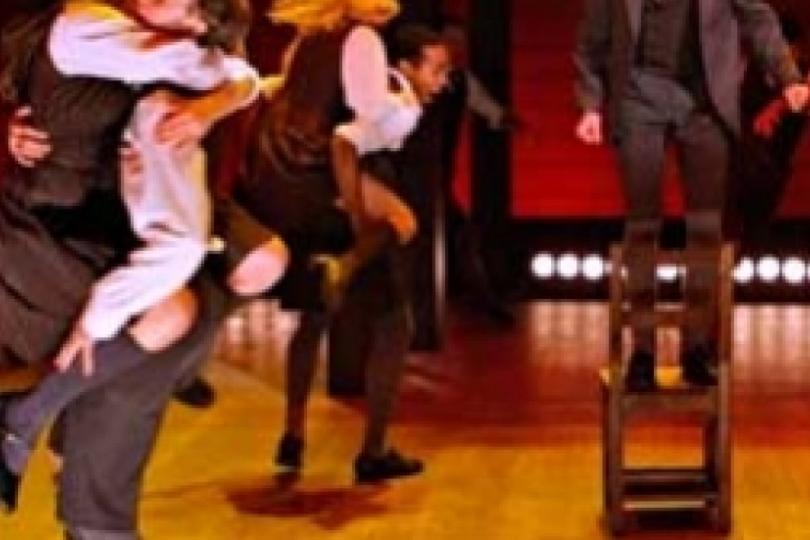Best of 2011-2012: Spring Awakening
Editorial

To all the musical theatre aficionados out there, I say: brace yourselves.
Although my theatrical tastes run a vast spectrum, including classical work, new writing, unscripted performance, site-specific pieces, and experimental drama, I rarely find myself drawn to musicals. You are welcome to find fault with me for this. The failing is mine. I accept it. You can blame an embarrassing love of Andrew Lloyd Weber during my formative years, but musicals now seem too brash. Too bold. Too on-the-nose in their emotional states and overt theatricality. Therefore, when contemplating what show of the past year had the greatest impact upon me, I was surprised to realize that it was a local production of a mainstream musical…
Spring Awakening, directed by Peter Rothstein and produced by Theatre Latte Da and the University of Minnesota, was an amazing experience. But before I delve too deeply into this specific production, I need to make a brief digression and confession about the play.
First, the digression: Frank Wedekind wrote his original (non-musical) play Frühlingserwachen in the 1890s. It was considered too risqué and remained unperformed until 1906, but even then it still shocked people. In 1917, it was translated into English as Spring Awakening and gained both recognition and notoriety for its graphic subject matter—puberty—which has made it a rather popular script for young independent producers to stage. The musical version of Spring Awakening hit Broadway in 2007, giving a new commercial life to this hundred and twenty year old script.
Now, the confession: I first encountered the play in 2003, when I played Melchior in a 90-minute version at the Minnesota Fringe Festival—and although this gave me a solid understanding of the material, I never grew to love it.
In 2007 I saw the Broadway musical Spring Awakening. It was a finely wrought production, but too polished for its own good, always aware of its effort to engage and court a young hip audience. It was well staged, but there was a falseness behind it – like a hip band playing in a Gap commercial. And with Broadway ticket prices being what they are, it was clear that all its projections of youth and passion were simply that – projections meant to lure people in. I got a $50 "rush ticket" and sat at the back of a thousand-seat house. It was certainly not an authentic experience. And none of the songs really engaged me.*
But here’s where the co-production between Theatre Latte Da and the University of Minnesota succeeded in a variety of profound ways. From the moment you entered the Rarig Thrust, the energy and proximity of this show were palpable. The audience was filled with students, family, teachers, and local community—not tourists—which made the experience of this production an event that unified its audience.
Whereas the original script was a highly critical attack of 19th century Germany morality – decrying the hypocrisy of the education system, social puritanism, and repressive parenting – the Latte Da/UofM musical production used these issues to emphasize a more timeless theme: the rebellious nature of youth. Instead of a simple attack against adult hypocrisy, this production was a rallying cry, an appeal to the young to take their fate into their own hands and refuse to accept the abuse that society forces upon them. The songs drove this approach, and by using a chorus of students, it highlighted the universal nature of the main characters’ feelings in a way that the original play never could. By turning personal experiences of helplessness and frustration into a unified expression of power, sensuality, and ferocity it approached the core of what it means to be young.**
Peter Rothstein’s direction emphasized the point by calling attention to the choices of four students who find themselves rejected by their education system: Melchior, Moritz, Wendla, and Elsa (played by David Darrow, Tyler Michaels, Cat Brindisi, and Larissa Gritti, respectively) and the different ways they approach their problems— rebellion, suicide, sacrifice, and resignation. Each character represents a possible path and exemplifies that choice through action. The downfall of these four characters is counterpointed by the subplot of Ernst and Hanschen (Jack Tillman and Grant Sorenson), two gay students who utilize and even embrace the hypocrisy of the system.
I was profoundly struck by the ability of Latte Da/UofM’s Spring Awakening to engage its audience in the raw expression of the ferocity, passion, and frustration of youth. By bringing the action close to the audience, it obliterated the aesthetic distance and translated the material into a cathartic audience experience. The play was not enamored of its own cleverness. It was not attempting to be hip. It had an effective but simple design. But it engaged the audience in a direct and meaningful way – through excellent storytelling, strong performances, Denise Prosek’s jaggedly beautiful musical arrangements and Carl Flink’s aggressively expressive choreography.
It also cannot be overstated that the Rarig Thrust was a phenomenal space for this play. The venue is sizable, but intimate, allowing the actors to regularly cross into the audience, which created an immersive atmosphere that made the entire room complicit in the play’s emotional journey. There was simply no avoiding the raw energy and passion of the performers. And those qualities of youthful unpredictability were further embraced by using every corner of the space in strange, nearly acrobatic ways: climbing the balconies, swinging down lighting poles, filling the aisles, climbing the musician’s box, descending into the smallest alcoves, as well as powerful stage choreography. The action occurred around you, and unlike the Broadway production, any true aesthetic distance was impossible.
I believe it was the best matinee performance I’ve ever seen. Admittedly, my experience may have been somewhat improved by a breakfast at the Triple Rock Social Club – but that’s also sort of the point. All experiences depend upon the context in which they occur. A theatrical event is deeply influenced by the collective mindset of its individual audience members, and this is where Spring Awakening truly excelled. The collaboration between Latte Da and the University of Minnesota’s Theatre Department fueled a real excitement for that show, driving ticket sales and creating a palpable enthusiasm for the work within the audience.
The show was filled with students, both onstage and off, and the commitment of all parties involved was clear. The audience was there to have a transcendent experience. And the performers were there to make that happen. The play evidently spoke strongly to them, and you could see this passion and love translate directly into their performances. But beyond simply being an excellent production, I have to applaud the work done by the producing organizations to create such excitement and passion for this play. While I don’t know the exact division of labor inherent in this collaboration, I was astonished that it managed to capture the best of both participants—the tremendous professional experience and refinement of Latte Da combined with the inherent talent and passion of the University of Minnesota’s students (along with a tremendous venue). This production wedded these shared resources into a transcendent theatrical whole.
* One exception: “Totally Fucked” is an excellent song no matter how you discover it.
** Perhaps these qualities also existed in the Broadway production. Somehow the in-your-face attitude failed to reach me in the second mezzanine.




